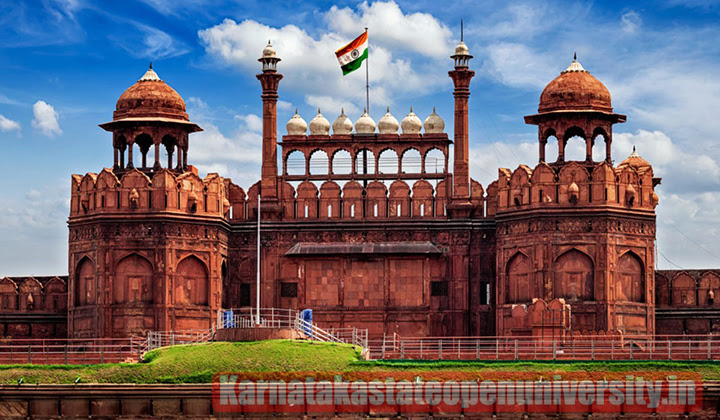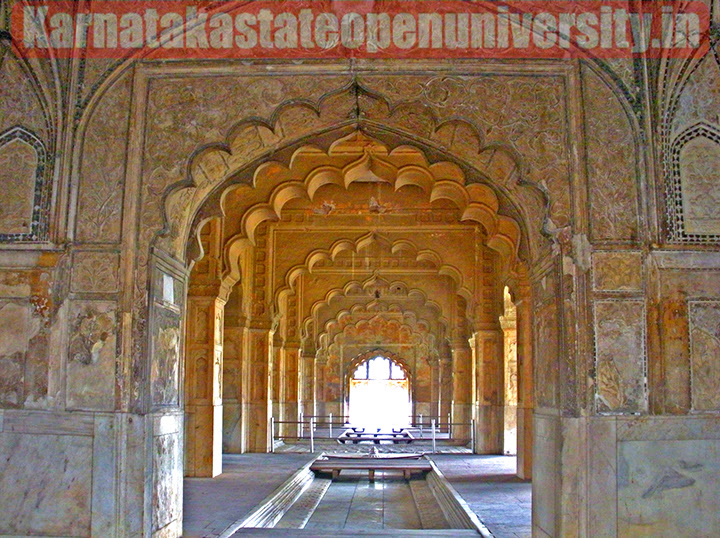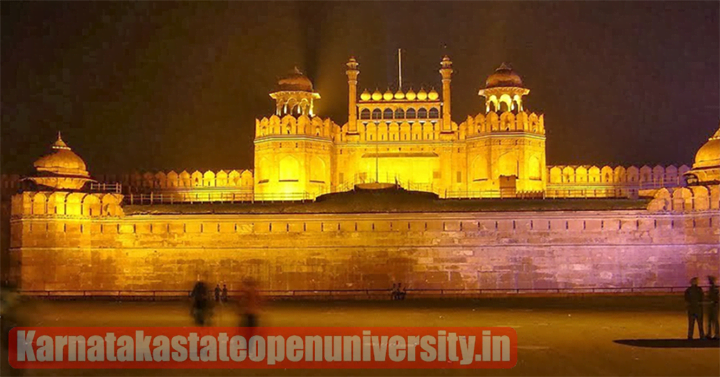Red Fort – In the old Delhi neighborhood is a historic fortification known as the Red Fort. It was built by Shah Jahan in 1639 as the capital moved from Agra to Delhi. This imposing structure, which served as the Mughal emperors’ primary residence, gets its name from its impregnable walls made of red sandstone. In addition to housing the emperors and their families, it served as the Mughal state’s ceremonial and political hub and the setting for significant regional events. Today, a number of museums house a collection of priceless artifacts at this monument. On Independence Day of each year, the Indian Prime Minister flies the national flag here.
Delhi’s Red Fort is a UNESCO World Heritage Site and one of the most popular tourist destinations in India. The fort is famous for its impressive architecture and for its many historical events, such as the battle of 1857 between British troops and the forces of Mughal Emperor Bahadur Shah Zafar. Today, the fort is a popular tourist destination, with visitors able to explore its many attractions including the Qutub Minar, the Aamir Khan Mosque, and the Lodhi Gardens.
Red Fort
The Red Fort, formerly known as Quila-e-Mubarak or the Blessed Fort, is located on the Yamuna River’s banks. Its waters supplied the moats that surrounded the fort. It was a piece of the middle age city of Shahjahanabad, prevalently referred to the present time as ‘Old Delhi’. It is said that the entire fort complex exemplifies the genius and originality of Mughal architecture. The Red Fort is one of India’s most well-known landmarks and a popular tourist destination in Delhi because of its rich heritage and history. In 2007, it was design a UNESCO world heritage site. This magnificent monument is currently under the protection and care of the Indian Archaeological Survey.
If you’re ever in Delhi, don’t forget to visit the Red Fort! This famous symbol of Indian heritage is a must-see for any visitor to the city. Not only is it an amazing sight, but it’s also a great place to learn about Indian history. The Red Fort was built by the Mughal Emperor Shah Jahan in 1639 as a tribute to his beloved wife Mumtaz Mahal. The architecture is colorful and imposing, and it’s a great place to spend a day if you’re in Delhi.

Red Fort Details
| Article for | Red Fort Delhi All you need to Know In 2024 |
| Red Fort Delhi All you need to Know In 2024 | Click Here |
| Category | Travel |
| Official website | Click Here |
click here:- Junagarh Fort Bikaner All you need to Know In 2024
The Lal Kila was the palace fort of Shahjahanabad, also known as Old Delhi, the fifth Mughal emperor Shah Jahan’s decision to move his capital from Agra to Delhi in 1648. In fact, his grandfather, Akbar the Great, built the Red Fort in Agra, which serves as inspiration for the Delhi Red Fort. The Salimgarh, an older fort that was built by Islam Shah Suri in 1546 and is part of the Delhi Red Fort Complex, is also part of the complex. It covers 49.1815 hectares, or 256 acres. The construction of this massive walled structure took nearly a decade. The Shah Jahan court’s Ustad Hamid and Ustad Ahmad started building it in 1638 and finished it in 1648.
The octagonal-shaped Lal Qila served as the seat of the Mughal Empire for approximately 200 years before the British took control. It was constructed on the banks of the Yamuna river, whose waters supplied the moats surrounding the fort.
History of Red Fort
On May 13, 1638, during the Muslim holy month of Muharram, work on Red Fort began. The Fort was construct over a period of nine years and was completed on April 6, 1648, under Shahjahan’s direction. In contrast to other Mughal structures, the walls were construct asymmetrically to contain the older Salimgarh Fort within its boundaries. Until the Great Revolt in 1857, it serve as the imperial Mughal capital. It is made up of a number of other buildings, some of which were built by Shah Jahan himself and others that were add by later rulers. Aurangzeb, his son and emperor, add the Pearl Mosque, also known as the Moti Masjid, to the fort complex after a bloody war of succession between him and his three brothers.
After Aurungzeb’s rule ended, the Fort began to decline. Farrukhsiyar, a different ruler, replaced the silver ceiling in 1712 with copper. In 1739, the Persian Sovereign Nadir Shah attacked Delhi and stole from the Red Stronghold, removing with himself the valuable Peacock privileged position.
Between 1739 and 1857, the Fort was taken by Ahmad Shah, Marathas, Sikhs, and the British, and it was also attacked, pillaged, and captured multiple times. In 1760, the Marathas sold the silver ceiling of Diwan-e-Khas in order to raise funds for the defense of armies against Ahmad Shah Durrani.
After the revolt of 1857, the last Mughal emperor, Bahadur Shah II, was exile to Rangoon. The Fort served as the Mughal throne for 200 years. He was the last Mughal resident of the Fort and served as a symbol for the 1857 revolt against the British in Shahjahanbad. The Mughals came to an end at this point. The British colonial rulers then occupied the fort and stole a lot of valuable items, including the Kohinoor diamond, the Jade Wine Cup of Shah Jahan, and the crown of Bahadur Shah II.
Furniture, gardens, harem apartments, and servant quarters were among the items they plan to remove from the Fort in a methodical manner. Nearly all of the inner structures were destroye, with the exception of the buildings made of white marble. Later in 1899, when Ruler Curzon turn into the Emissary of India, he requested recreation of the structure and gardens were likewise reestablish. The first Prime Minister, Jawahar Lal Nehru, unfurle the National Flag from Lahori Gate after the British left India. Since then, every Independence and Republic Day, the Prime Minister gives a ceremonial speech at the Red Fort and unfurls the National Flag.
Architecture of Red Fort
The Red Fort is an exceptional monument because it combines elements of Indian, Persian, and Timurid architecture. Ustad Ahmad Lahauri, who also designed the Taj Mahal, was the Red Fort’s architect. A two-kilometer perimeter wall that served as an effective defensive measure surrounds it.
The fort has an octagonal structure and a number of gates, the most prominent of which are the Lahori, Ajmeri, Kashmiri, Mori, Turkman, and Delhi gates.Several structures are house within the premises of the Red Fort. The Moti Masjid, the Nahr-i-Bashisht (stream of paradise), and the Diwan-i-Aam are the most well-known among these.
The “Diwan-i-Am,” also known as the “Hall of Public Audience,” is a rectangular hall with nine arch facades and three aisles. Six marble palaces were originally located along the eastern water front. The Nahr-i-Bihisht, or “Stream of Paradise,” is a water channel with an ivory fountain and a marble basin in the middle. The Delhi Fort Museum is now house in the Mumtaz-Mahal. The Diwan-I-Khas (‘Corridor of Private Crowd’) is a perfectly enrich pillared lobby, with a level roof upheld by engrailed curves.
It is said that Nadir Shah stole the Peacock Throne from here. The Hammam, or “Bath,” is divide into three main sections by corridors. Marble is use throughout the interior, including the floor, which is inlaid with color stones. Aurangzeb later added the “Pearl Mosque,” Moti-Masjid, to the west of the Hamman. The red-stone pavilion known as Zafar-Mahal was made by Bahadur Shah II around 1842 in the middle of the tank in the Hayat-Bakhsh-Bagh.
Precious stones and intricate floral designs were inlaid on the majority of these buildings. The most significant aspects of the Red Fort’s architecture are its singular cuspe arches, highly intricate ornamentation, and double domes, which became a hallmark of Shahjahani architecture.

Red Fort Political Significance
Red Fort was a location where people marched in large numbers to show their support for a nation they aspired to call their own and was the scene of political upheaval, campaigns, and protests. Throughout the Indian freedom struggle, the fort has witnessed shedding of blood, sweat, and tears. The day after Nehru’s infamous “Tryst with Destiny” speech, the first Prime Minister of the independent state addressed the fervent crowds at the Red Fort and raised the Indian flag, a sign of the newfound freedom heralding a new era of liberation, belonging, and existence. A time when India would become the world’s largest democracy. Furthermore, the custom continues.
From the red rampart, the current Prime Minister addresses the waiting nation each Independence Day. The fort’s old walls have seen it all. With each passing year, the fort has been witness to the rambling speeches of the leaders while the jubilant crowds cheering for a future filled with hope have reverberated through its walls. The fort still embodies India’s spirit to this day, with the prime minister hoisting the Tricolor and the skies filled with the flag’s colors. It is deeply ingraine in Indian culture and has a unique place in the country’s and people’s ceremonial ethos. It is synonymous with our freedom, standing tall as a guard of honor to welcome new leaders and visitors who come annually to remember the hardships we endured to achieve it.
Light and Show
Red Fort is visited by many tourists for the significant historical relevance that holds. But other than the red sandstone and the mighty building of the medieval times, there is an another attraction that it brings the tourists to the Blessed Fort- Light and Sound Show.
The show, held every evening except Mondays, is a one hour fest of lights and sounds which that takes place inside the premises of the Fort. There’s no better way to learn about the history of the Red Fort. The shows are both in English and Hindi at different timings of:
Hindi– 7:30 PM – 8:30 PM
English– 9:00 PM – 10:00 PM
Tickets: Weekdays – INR 60 for adults and INR 20 for children
Weekends and Government Holidays – INR 80 for adults and INR 30 for children

check:- Mehrangarh Fort In Jodhpur All you need to Know in 2024
Best time to visit
The best time to visit this Red Fort is during the months of September- March, when the weather is pleasant.
Tips
1. Videography is permitted. You have to pay INR 25 per camcorder.
2. The Red Fort remains closed on Sundays.
Reviews
The Red Fort is famous for its enormous enclosing walls, which were made by Mughal emperor Shah Jahan as the palace fort of his capital, Shahjahanabad. Between 1638 and 1648, the fort’s construction was complete in ten years. Because of its red sandstone rampart walls, this palace fortress is call the Red Fort. In 1648, the fort with its halls, palaces, pavilions, and tranquil gardens was finish. Numerous fairytale structures can be found within the red fort’s enclosure. The two most prominent structures within the Red Fort are the Diwan-i-Khas, also known as Shah Mahal, and the Rang Mahal, also known as the Imtiyaz Mahal or “palace of distinctions.”
Another well-known structure that can be found within the Red Fort is the Hall of Public Audience (Diwan-i-Aam). Every evening, Son-et-lumiere shows take place in the Red Fort. These shows tell the story of the Mughal Empire in India, from its glory to its tragic end.
Read Also:-
Gwalior Fort In Madhya Pradesh All you need to Know in 2024
Jaisalmer Fort: Golden Fort of Rajasthan All you need to Know In 2024

